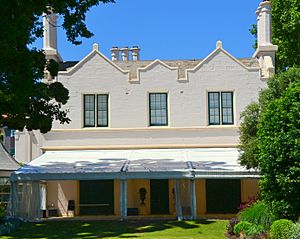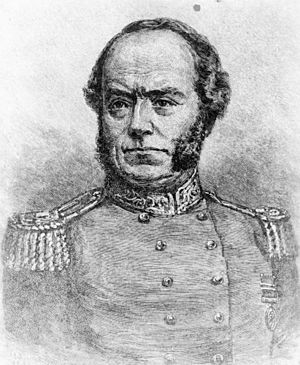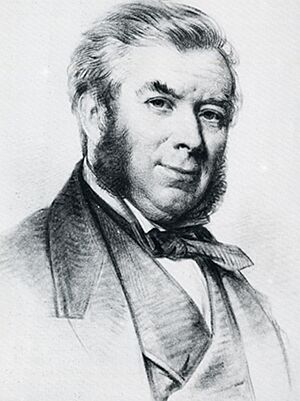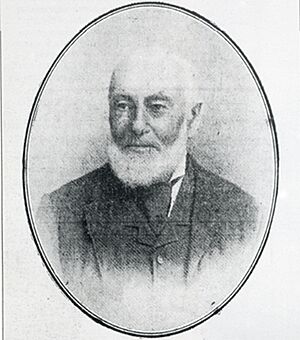Lindesay, Darling Point facts for kids
Quick facts for kids Lindesay |
|
|---|---|

Lindesay today
|
|
| Location | 1a Carthona Avenue, Darling Point, Sydney, Australia |
| Built | 1834–1836 |
| Architect |
|
| Architectural style(s) | Gothic Revival |
| Owner | National Trust of Australia (NSW) |
| Official name: Lindesay | |
| Type | State heritage (complex / group) |
| Designated | 2 April 1999 |
| Reference no. | 686 |
| Type | Villa |
| Category | Residential buildings (private) |
| Lua error in Module:Location_map at line 420: attempt to index field 'wikibase' (a nil value). | |
Lindesay is a special old house in Darling Point, Sydney, Australia. It's now used for offices, events, and as a museum you can visit. The house was built between 1834 and 1836 and was designed by several architects. It's owned by the National Trust of Australia (NSW), which helps protect important places. Lindesay was the very first big house built on Darling Point. It's famous for being one of the earliest examples of the Gothic Revival style in Sydney, which means it looks a bit like a medieval castle! Many interesting people who helped shape the history of New South Wales once lived here.
History of Lindesay House
Darling Point's Early Days
The area where Lindesay stands was originally known by its Aboriginal name, Yarranabbee. Later, Governor Ralph Darling named it Mrs Darling's Point after his wife, Eliza. Back then, it was covered in thick forests. After a new road was built in 1831, many trees were cut down, and the land was divided into smaller plots.
Between 1833 and 1838, many people bought land here. Soon, the area became known as Darling Point. Important people like Sir Thomas Mitchell, a famous explorer, built homes here. Lindesay was one of these grand early homes.
Building Lindesay
Lindesay was built between 1834 and 1836 for Campbell Drummond Riddell, who was the Treasurer of New South Wales at the time. He was a young man from Scotland. He and his wife, Caroline, moved into the house with their two-year-old son in 1836. The property was quite large, about 17 acres, and included stables and gardens that stretched down to the harbour.
The house was designed as a "villa," which means it was a free-standing building with different looks on each side. This style was popular in Britain. Lindesay has a simpler design, mixing Scottish style with a touch of colonial freedom. It was named after Colonel Patrick Lindesay, who was acting governor for a short time. He helped Riddell get the land for the house.
Famous Owners of Lindesay
The Riddells only lived at Lindesay for two years. After them, many interesting people owned the house:
The Mitchell Family's Time
In 1841, Sir Thomas Mitchell, the Surveyor-General of NSW, bought Lindesay. He was a famous explorer who led three big trips into Australia's interior. He was even knighted for his work! He bought Lindesay so he could be close to where his own house, Carthona, was being built nearby. His youngest daughter, Blanche, was born at Lindesay in 1843. In 1845, the Mitchell family moved into Carthona, and Sir Thomas sold Lindesay to his friend, Sir Charles Nicholson.
Sir Charles Nicholson, the Collector
Sir Charles Nicholson bought Lindesay in 1845. He was a medical doctor who became very wealthy. He loved collecting rare books, old objects, and art. He had one of the biggest private libraries in the colony at Lindesay, and even a special room for his statues! Sir Charles later helped start the University of Sydney and became its chancellor. He sold Lindesay in 1849.
William Bradley and His Daughters
After Sir Charles, William Bradley bought Lindesay in 1849. He was a very rich farmer who owned lots of land. Sadly, his wife died in Europe, leaving him to raise their five daughters alone. He brought them up at Lindesay. One of his daughters, Esther, sadly passed away at the house when she was only 22. William Bradley died at Lindesay in 1868.
The Macintosh Family's Long Stay
John Macintosh bought Lindesay in 1868 and lived there for 43 years, longer than any other owner! He had a tough start in life, working hard from a young age. He taught himself and became a successful businessman. He and his wife, Caroline, had ten children. While living at Lindesay, John Macintosh built two other houses on Darling Point for his children, named Braeside and Cintra. He passed away at Lindesay in 1911.
The Jenkins Family
Dr. Edward Jenkins bought Lindesay in 1914. He was a doctor who grew up in a large house built by Thomas Mitchell. He and his wife, Annie, had three children. Their daughter, Judith, loved photography and took many pictures of their family outings and holidays. The Jenkins family moved to a smaller house in 1926.
The Pye Family and the National Trust
Charles and Mary Pye bought Lindesay in 1926. Charles was a wealthy farmer. After he passed away, his widow, Mary, stayed at the house until her death in 1961. Her son, Walter Pye, inherited Lindesay in 1963. He made a very generous decision to donate the house and some furniture to the National Trust of Australia (NSW).
Since 1963, the National Trust has looked after Lindesay. They use it for offices, public events, and exhibitions. Volunteers and committees work hard to raise money to keep the house and gardens beautiful.
Restoring the Gardens
In the 1960s, a group was formed to bring the gardens back to how they might have looked in the 19th century. They focused on keeping the amazing harbour view. They planted trees and plants to frame this view and hide nearby buildings.
Today, the gardens are still cared for by volunteers and a professional gardener. They have a modern planting plan that still respects the past, making sure the garden looks good all year round for events like weddings. There's a formal courtyard garden with gravel paths and low hedges, watched over by beautiful 19th-century Italian statues called "the Four Seasons."
What Makes Lindesay Special Today
Lindesay is very important for many reasons:
- It was the first big house built on Darling Point in the 1830s.
- It's a great example of the early Gothic Revival style in Sydney, looking like a charming old castle.
- Many important people in New South Wales history lived here, like explorers, politicians, and collectors.
- The house has beautiful rooms with special old features, including a fancy fireplace.
- It helped set the standard in 1963 for how to restore and use historic houses to teach people about the past.
- You can still see Lindesay from Sydney Harbour, just like people could in the 1830s!







